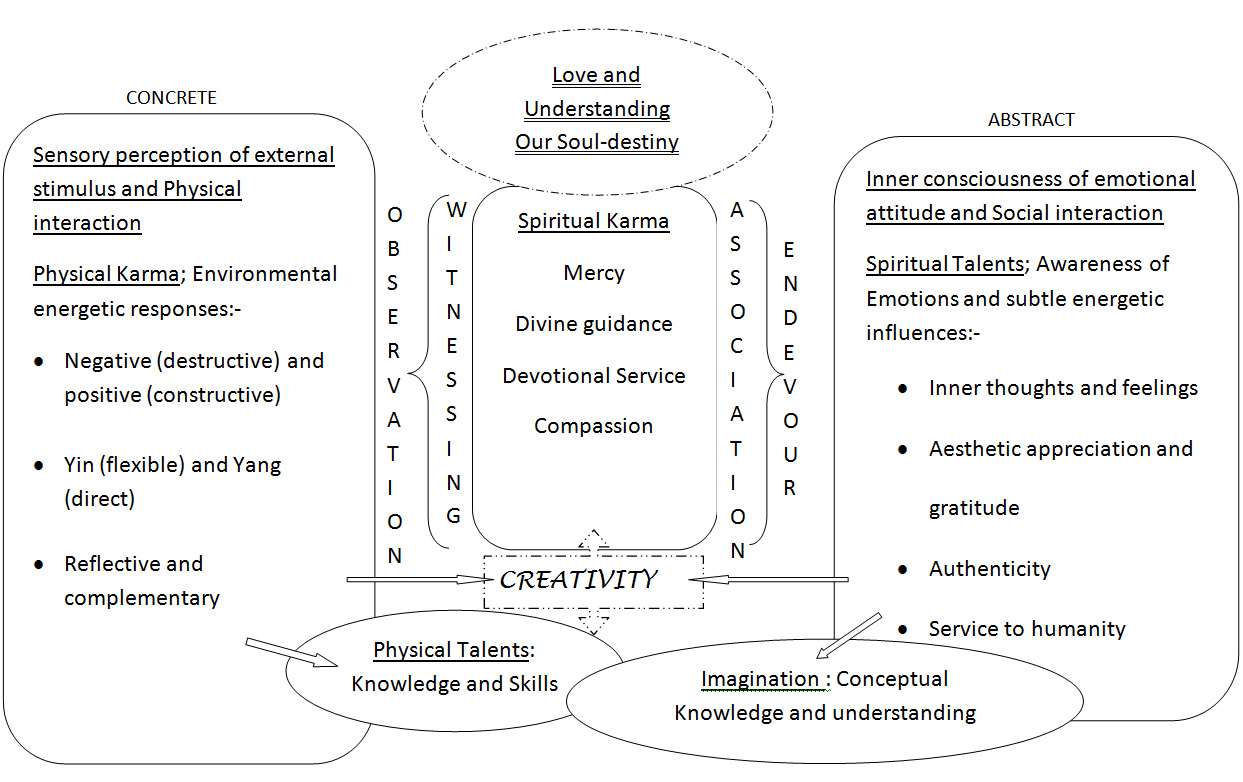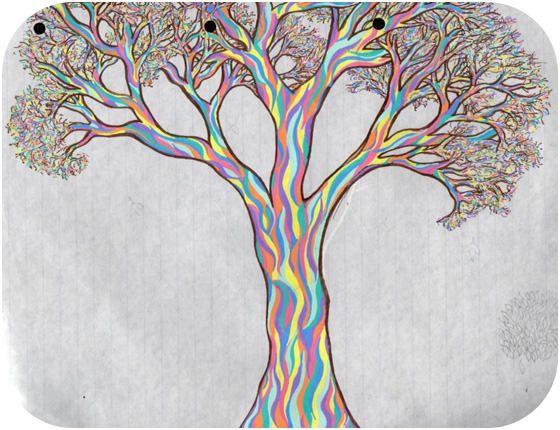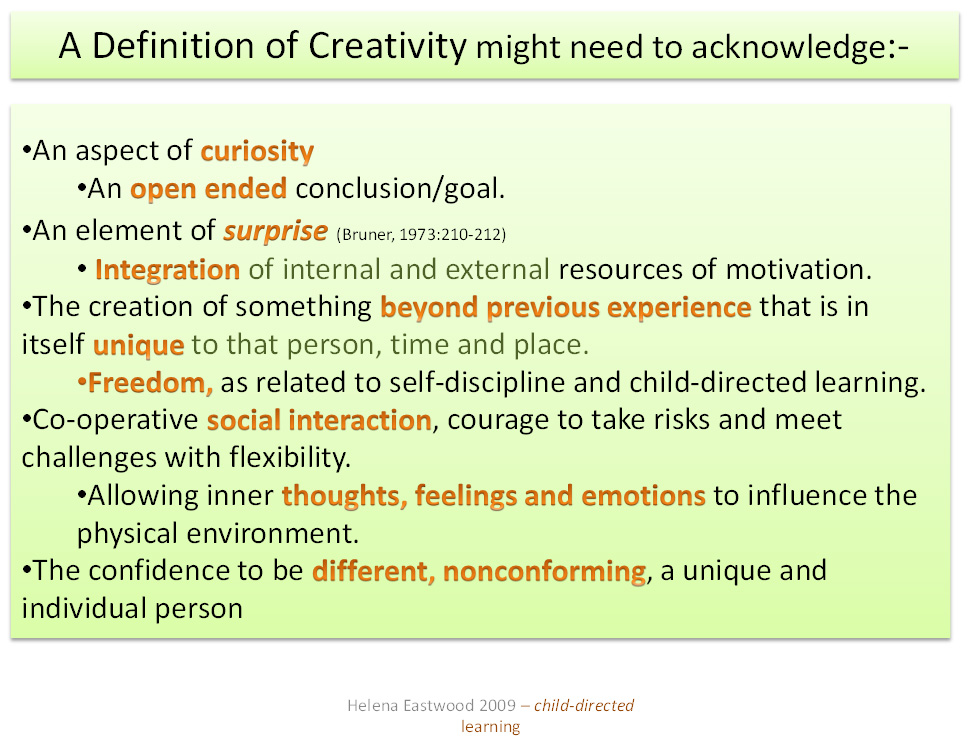Only through the power of unconditional love can we hope to provide an abundance of creative opportunity for personal empowerment and self-directed learning.
Creativity and co-operative interaction are the foundations of learning. Multisensory integration creates depth and richness to our interaction with the world around us through the heart and soul-spirit. Thus when multi-sensory information is framed within areas of creative freedom and passionate interaction learning can be experienced as personal discovery within an infinite future potential for meaningful expansion.
Creativity, multisensory learning, aesthetic appreciation and divergent thinking plus some heart magic, are born when ideas, feelings and experiences flow togerther like the water within a stream, where an infinite freedom is contanined within the boundaryies of the geographical terain and the earthly laws of physics.
- As the daylight dissipates the darkness of the night
The sun’s rays shine across the land,
My soul leaps in the hand of the Lord’s goodness.
As we share in the light of this new day
Our gratitude and reverence for work and play.
We give thanks for the divine grace that shines within us,
Our individual personalities that enrich our sharing,
And the joy of creativity that guides our learning together.
In her peace message Amma (Sri Mata Amritanandamayi Devi Geneva 2002) spoke the following words “What everyone needs is peace, but the majority want to be king. No one wants to be a servant. How then can there be peace? Won’t there be war and conflict? A true servant is the real King. Isn’t the milk from the black cow, and the white cow, and the brown cow the same?”
Similarly the essence in every person is the same. Peace and contentment are the same for everyone. Those who desire them should work together.”
Our fullest potential is present within the very essence of our being from which we express our original nature, the very essence of positive and joyful living. The diagram below presents a simplified consideration of how we can express the sweetness of our unique potential out into to the world around us.

The Nature of Creativity
Aesthetic appreciation, creative activity, problem solving, imagination and fantasy all appear to be interrelated within definitions of creativity which, in itself is a quality that ‘makes us uniquely human.’ (Duffy,2006:23
‘As human beings we need to exercise our creativity and imagination we need to represent our thoughts, impressions and feelings.’(Duffy,2006:5)
 ‘By encouraging creativity and imagination we are prompting children’s ability to explore and comprehend their world and increasing the opportunity to make new connections and reach new understandings.’ (Duffy,2006:8)
‘By encouraging creativity and imagination we are prompting children’s ability to explore and comprehend their world and increasing the opportunity to make new connections and reach new understandings.’ (Duffy,2006:8)
When adults teach how they think things should be the child’s natural desire to please may dominate their natural creativity with actions related to social inter-dependence.
‘Children should be taught that being open minded does not threaten their integrity but affirms their work as human beings.’ (Fisher 1990:67)
The ‘All our futures’ report suggests that ‘the potential for creative achievement is in all fields of human activity;’ and ‘possibly in all fields of human intelligence;….creativity is obviously to do with producing something original’ and ‘everyone is capable of creative achievement …….According to their own strengths and abilities’ (DfEE,1999:27-28).

‘All children are born with creative ability but it is up to us to provide a climate to support the child’s creative efforts.’ (Fisher,1990:34)
Do schools Kill Creativity – Sir Ken Robinson, U Tube – Ted Talks.
 Creativity is something more that an interpretation of something we know, it represents a way of expressing how we feel and who we are.
Creativity is something more that an interpretation of something we know, it represents a way of expressing how we feel and who we are.Montessori presents that ‘during the early years the child’s creative powers are formulated during a creative period.’(Montessori,1988:196)
Vygotsky suggests that during a ‘sensitive period’ an ‘influence that has little effect earlier or later may radically affect the course of development’ and that his investigations demonstrated that ‘the social and cultural nature of the development of higher functions during these periods’ is dependent upon ‘cooperation with adults and on instruction’. (Vygotsky,1986:189)
This suggests that adults within the context of those wishing to facilitate children’s learning do have some responsibility for how children’s creativity flourishes or fades.
How can the adult successfully balance what may appear to be opposing issues such as:-
| Holding responsibility for the welfare of the children and the care of the environment | -v- | Mutual respect as equals |
| Apprenticeship to someone with superior knowledge and skills. | -v- | Equality in learning |
| Teaching and taught | -v- | Teaching without issues of control, agenda or judgment of results |
| A presentation of truthful information and opinion. | -v- | Non-interference |
| Adult organization of interesting & enriching classroom activities | -v- | Shared learning and genuine interchange of ideas. |
| Scaffolding | -v- | Freedom in actions and thoughts: Child-Directed Learning |
Defining Creativity
Duffy describes creativity as ‘connecting the previously unconnected in ways that are new and meaningful to the individual concerned’ and suggests that ’play promotes the flexibility and problem solving skills that are needed to be creative.’(Duffy,2006:8,23)
She describes the role of the adult as that of creating conditions which inspire children to be creative and imaginative through a commitment to the cycle of practical application she describes as : ‘implementing, observing, recording, assessing, planning.’ (Duffy,2006: 132)
Duffy also emphasises that adult interactions should:-
– embrace sensitivity and authenticity(Duffy,2006:94-95)
– recognise that the actual process ‘is often more important in encouraging creativity than the solution or end product’.(Fisher,1990:39)
– appreciate the child’s social desires to ‘represent and communicate his experiences’. (Duffy,2006:94-95)
Bernard defines creativity as ‘a search for new meanings and solutions that combine, invent and synthesise.’ He also presents ‘the essence of creativity is to be unpredictable’ and therefore suggests that it is ‘contradictory to describe what can be done to encourage it’ and that the organisation of materials and activities to support children’s creative development within the classroom cannot be prescribed. (Bernard,1965:75,92)
He suggests ‘the creative person is divergent and adventuresome’ and ‘the teacher must be competent and confident’ enough to ‘allow pupils freedom’ so that through her own ‘personality and resourcefulness’ and her own ‘unique combination of experience, interests, perceptions and attitudes’ she can foster creativity within the social and cultural context of the classroom. (Bernard,1965: 75,94,474,92)
Fisher suggests that creativity is derived from the disposition ‘to be curious, to wonder and to question.’ (Fisher,1990:3) He illustrates this in the diagram below:-


Hughes, suggests there is an association between play, creativity and problem solving. He describes play as ‘intrinsically motivated’- ‘freely chosen’ –‘pleasurable’ and for creative play he extends this definition to include: ‘imaginative’, ‘personality characteristic’, ‘an intellectual process’ with a ‘creative product’. Hughes goes on to describe divergent problem solving as ‘the ability to branch out from a starting point and consider a variety of possible solutions’ and that this is often linked to the processes involved in creative thinking and fantasy play. He describes intellectual flexibility as ‘a key ingredient in the creative process’ Hughes also suggests that using the imagination to direct external learning through play activities involves ‘decentration’ – ‘the abil¬ity to attend simultaneously to many features of one’s environment, to transform objects and situations while at the same time understanding their original identities and states, to imagine things as they are and also as they were’ (Hughes,1991:2,185-188) or could be. Piaget (1969) describes ‘decentering’ as prerequisite to the formation of operations relating to our physical, interpersonal and social cognitive constructions. (Piaget,1969:94-95)
Boden describes creativity as ‘unfamiliar combinations of familiar ideas ’ and suggests a ‘novel combination requires a rich store of knowledge.’ She associates creativity with play because both are ‘often open ended, with no particular goal or aim’ (Boden,2004:3,59)

